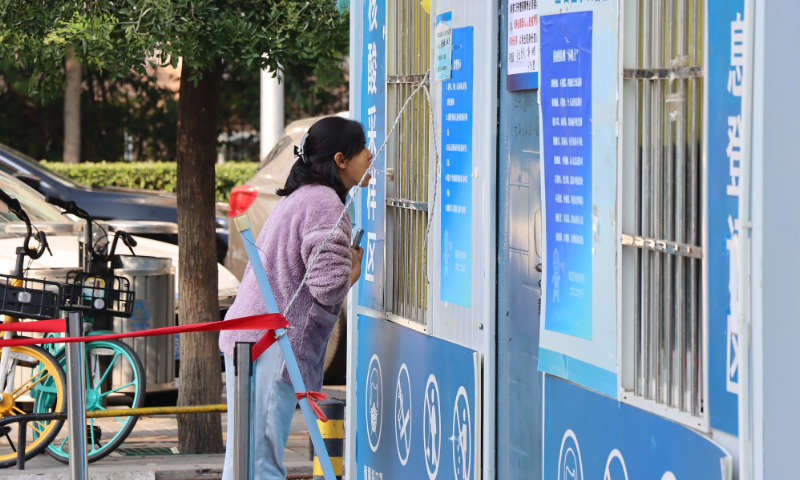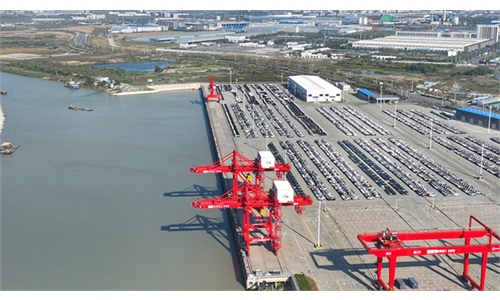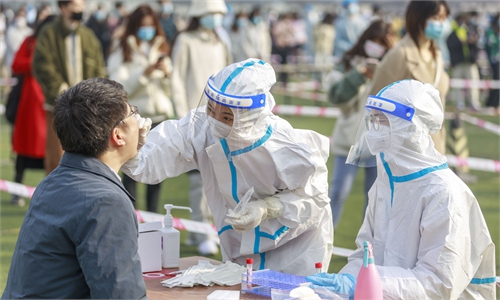Authority of COVID-hit regions cannot replace precise measures with static management: NHC

A resident takes nucleic acid testing in Haidian district in Beijing on October 7, 2022. Photo: VCG
Authority of regions hit by COVID-19 resurgences cannot replace precise anti-epidemic control measures with static management, an official from the National Health Commission (NHC) stressed on Thursday, highlighting a precise and science-based approach to minimize the impact of the COVID-19 epidemic on economic and social development.
"Shutting down everything should be absolutely avoided," stressed Lei Zhenglong, an official from the NHC. He emphasized three "cannots" for regions affected by COVID-19: anti-epidemic measures cannot be simplified, risk regions cannot be expanded and control measures cannot be replaced with static management.
Instead, precise work should be carried out in epidemiological investigation and defining risk regions. At the same time, decisive control measures should be imposed and dynamically adjusted in accordance with the epidemic situation. Restrictions should be lifted in regions that have met anti-epidemic requirements, Lei noted.
When a city imposes static management, local residents would be asked to stay indoors and public transportation would be suspended. This aims to slow down the possible transmission of COVID-19 in a city or a confined area so as to cut off the spread of chains. Where static management was imposed, it generally came along with mass nucleic acid testing.
"One of our goals of epidemic prevention and control is to obtain positive results with as little cost as possible. That is to say, the goal of our prevention and control is to avoid citywide static management as much as possible, instead of taking it as a means that we must take," Liang Wannian, head of China's COVID-19 response expert panel under the NHC, further elaborated at the press conference held by the State Council joint prevention and control mechanism against COVID-19.
Explaining how to avoid citywide static management, Liang said that the implementation of "four early" practices - early finding, early reporting, early confirming and early quarantine - is the key. The goal is to control outbreaks at an early date and on a small scale with precise measures.
However, due to the characteristics of Omicron, we cannot detect positive cases rapidly. If an outbreak is found late, especially when transmission chains are yet to be clear or when affected areas are broad, precise regional static management should be taken as a means to control its spread in a quick manner, Liang noted.
Commenting on domestic outbreaks, the NHC officials said the epidemic situation nationwide is still severe and complicated. COVID-19 outbreaks in Northwest China's Xinjiang Uygur Autonomous Region have repeatedly emerged but are generally controllable, and the epidemic in Northwest China's Inner Mongolia Autonomous Region has improved with declining cases. More provinces are having sporadic cases.
NHC data released on Thursday showed that the daily number of confirmed cases across the Chinese mainland was 322 and asymptomatic cases stood at 1,154.
At the conference, the NHC stressed that China unswervingly adheres to a prevention strategy against imported cases and resurgences at home, and sticks to the dynamic zero-case policy.
Liang said initial results have been achieved as we have eyed the dawn of victory in epidemic prevention and control, but the country has not yet reached victory's other shore.
A complete end to the epidemic or a complete victory over the epidemic requires reaching a balance of the factors of the mutated variants, spectrum of infection, severity of virus and health system's resistance to COVID-19, as well as the country's epidemic control capabilities and the medical system's intervention capacity, Liang said.
Global Times


